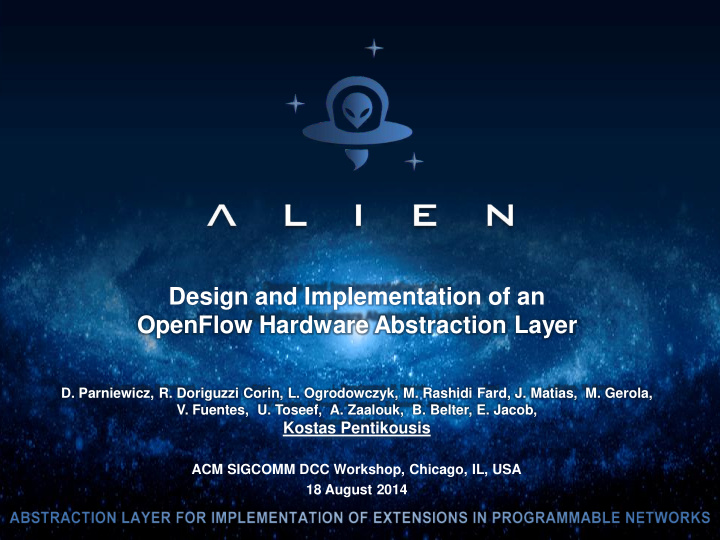



Design and Implementation of an OpenFlow Hardware Abstraction Layer D. Parniewicz, R. Doriguzzi Corin, L. Ogrodowczyk, M. Rashidi Fard, J. Matias, M. Gerola, V. Fuentes, U. Toseef, A. Zaalouk, B. Belter, E. Jacob, Kostas Pentikousis ACM SIGCOMM DCC Workshop, Chicago, IL, USA 18 August 2014
Motivation • SDN is reshaping network infrastructure – From campus networks to data centers to global-scale network infrastructures to distributed cloud computing – Rethinking network control and operation – Assumption: An OpenFlow-based control plane will become common in the future • But, a range of existing provider domains are not OpenFlow-ready – Support deployment beyond Ethernet-like networks – Shield implementation from velocity and scope of protocol specification changes – Consider real-world hardware platforms such as DOCSIS & DWDM – Transform (legacy) network elements into OpenFlow-capable devices
ALIEN Hardware Abstraction Layer • Modular system and software architecture – Designed for a large array of devices • Programmable platforms (NetFPGA, traditional NPU, multicore CPUs with hardware network enhancements, standard CPUs with software network enhancements) • Lightpath devices (DWDM ROADM) • Point to multi-point access networks (DOCSIS, GEPON) – Decoupling of hardware-specific control and management logic from the network node abstraction – Software reusability • Support multiple OpenFlow versions • Hide device complexity, technology- and vendor-specific features from the control plane logic
HAL Functional Schematic
HAL Components and Interfaces • Cross-Hardware Platform Layer – OpenFlow Endpoint – OpenFlow Pipeline – Virtualization Agent • Hardware Specific Layer – Discovery – Orchestration – Translation • Abstract Forwarding API (AFA) • Hardware Pipeline API (HPA) • NETCONF/OF-CONFIG
HAL Implementation
H Λ L in Λ ction • EWSDN 2014 (in two weeks, save the date!) • FIA Athens 2014 – Video-on-demand in OpenFlow networks – Distributed and version-agnostic OpenFlow slicing mechanism – Integration of legacy DOCSIS access network under OpenFlow control • TERENA Networking Conference 2014
Conclusion • OpenFlow support is lacking in production environments where most of the forwarding devices are based on either closed platforms or legacy hardware which is incompatible with the protocol • The ALIEN HAL addresses this gap – Software architecture and implementation which aims to complement conventional hardware platforms – Viable, experimentally-tested approach – Platform for development and deployment of OpenFlow on network elements that do not support the protocol out-of-the-box • Decoupling of hardware-specific control and management logic from the OpenFlow node abstraction logic • Current work: Introduce HAL devices to the OFELIA pan-European SDN experimental facility
Further Reading • D. Parniewicz, R. Doriguzzi Corin, et al., “Design and Implementation of an OpenFlow Hardware Abstraction Layer”, Proc. SIGCOMM DCC 2014 , Chicago, USA, August 2014. • L. Ogrodowczyk, B. Belter, et al., “Hardware Abstraction Layer for non - OpenFlow capable devices”, Proc. TERENA Networking Conference, Dublin, Ireland, May 2014 • M. Rashidi (Ed.) et al., Specification of Hardware Abstraction Layer . FP7 ALIEN Deliverable D2.2, available at www.fp7-alien.eu, 2014. • U. Toseef (Ed.) et al., Report on implementation of the Common Part of an OpenFlow Datapath Element and the Extended FlowVisor . FP7 ALIEN Deliverable D2.3, available at www.fp7-alien.eu, 2014. • Software – Revised OpenFlow Library (ROFL) – eXtensible OpenFlow datapath daemon (xDPd) – xDPd-Virtualization plugin (git) – eXtensible Control Path daemon (xCPd)
www.fp7-alien.eu Acknowledgement This work was conducted within the framework of the FP7 ALIEN project, which is partially funded by the Commission of the European Union under grant agreement no. 317880
Recommend
More recommend